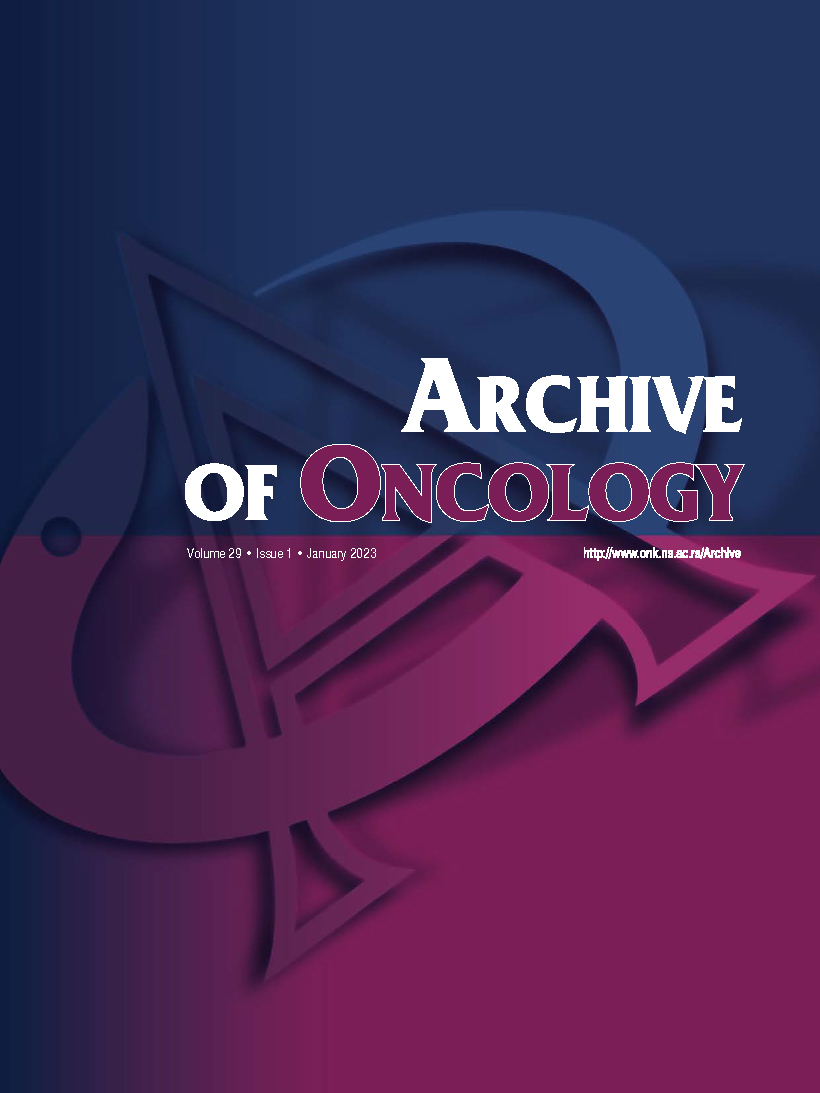Pre-treatment neutrophil-lymphocyte and monocytelymphocyte ratios give clues about response, survival, and recurrence in diffuse large B-cell lymphoma
Abstract
Background: Diffuse large B cell lymphoma is a heterogeneous tumor group consisting of large and transformed B cells that makeup 30-40% of all non-Hodgkin lymphoma. Numerous studies point out that initial parameters and posttreatment responses can be used as prognostic factors. We aimed to examine the relationship between diagnosis, clinical and laboratory parameters, treatment response and survival using neutrophil-lymphocyte and monocytelymphocyte ratios. Methods: A total of 80 patients, followed in our hematology clinic between January 2009-2019, were included in the study and were analyzed retrospectively. Results: The median value of neutrophil- lymphocyte ratio was 3.5 (0.3-50.2) and of monocyte-lymphocyte ratio was 0.3 (0.1-4.8). In the group with neutrophil-lymphocyte ratio ≥ 3.5 response rates was significantly lower and exitus rate and the bulky mass presence were significantly higher compared to the group with > 3.5 values (p < 0.05). In the group with monocyte-lymphocyte ratio ≥ 0.30, the exitus rate was significantly higher compared to group with < 0.30 values (p < 0.05). Conclusion: A statistically significant bulky mass presence was demonstrated in the population above the neutrophil-lymphocyte ratio and monocyte-lymphocyte ratio cut off. Although not considered to be sufficient alone, these parameters could be used as prognostic factors in combination with current scoring systems.
References
References:
Iqbal J, Joshi S, Patel KN, Javed SI, Kucuk C, Aabida A, d'Amore F, Fu K. Clinical implication of genome-wide profiling in diffuse large B-cell lymphoma and other subtypes of B-cell lymphoma. Indian J Cancer. 2007;44:72-86. doi:10.4103/0019-509x.35814.
Shenoy PJ, Malik N, Nooka A, Sinha R, Ward KC, Brawley OW, Lipscomb J, Flowers CR. Racial differences in the presentation and outcomes of diffuse large B-cell lymphoma in the United States. Cancer. 2011 Jun 1;117(11):2530-40. doi:10.1002/cncr.25765.
Morgan G, et al. Changing trends in the incidence of non-Hodgkin's lymphoma in Europe. Biomed Study Group. Ann Oncol. 1997;8(2):49-54. doi: 10.1093/annonc/8.suppl_2.S49.
Armitage, James O. How I treat patients with diffuse large B-cell lymphoma. Blood. 2007;110(1):29-36. doi:10.1182/blood-2007-01-041871.
Nagel S, Hirschmann P, Dirnhofer S, Günthert U, Tzankov A. Coexpression of CD44 variant isoforms and receptor for hyaluronic acid-mediated motility (RHAMM, CD168) is an International Prognostic Index and C-MYC gene status-independent predictor of poor outcome in diffuse large B-cell lymphomas. Exp Hematol. 2010;38(1):38-45. doi:10.1016/j.exphem.2009.10.010.
Jovanović MP, Jaković L, Bogdanović A, Marković O, Martinović VC, Mihaljević B. Poor outcome in patients with diffuse large B-cell lymphoma is associated with high percentage of bcl-2 and Ki 67-positive tumor cells. Vojnosanit Pregl. 2009 Sep;66(9):738-43. doi:10.2298/vsp0909738p.
Shipp MA. Prognostic factors in aggressive non-Hodgkin's lymphoma: who has "high-risk" disease? Blood. 1994 Mar 1;83(5):1165-73.
Sehn LH, Berry B, Chhanabhai M, Fitzgerald C, Gill K, Hoskins P, Klasa R, Savage KJ, Shenkier T, Sutherland J, Gascoyne RD, Connors JM. The revised International Prognostic Index (R-IPI) is a better predictor of outcome than the standard IPI for patients with diffuse large B-cell lymphoma treated with R-CHOP. Blood. 2007 Mar 1;109(5):1857-61. doi:10.1182/blood-2006-08-038257.
Mu S, Ai L, Fan F, Qin Y, Sun C, Hu Y. Prognostic role of neutrophil-to-lymphocyte ratio in diffuse large B cell lymphoma patients: an updated dose-response metaanalysis. Cancer Cell Int. 2018 Aug 22;18:119. doi:10.1186/s12935-018-0609-9.
Azuma Y, Nakaya A, Fujita S, Satake A, Nakanishi T, Tsubokura Y, Saito R, Konishi A, Hotta M, Yoshimura H, Ishii K, Ito T, Nomura S. Neutrophil-to-lymphocyte ratio (NLR) fails to predict outcome of diffuse large B cell lymphoma. Leuk Res Rep. 2019 May 25;12:100173. doi: 10.1016/j.lrr.2019.100173.
Ho CL, Lu CS, Chen JH, Chen YG, Huang TC, Wu YY. Neutrophil/Lymphocyte Ratio, Lymphocyte/Monocyte Ratio, and Absolute Lymphocyte Count/Absolute Monocyte Count Prognostic Score in Diffuse Large B-Cell Lymphoma: Useful Prognostic Tools in the Rituximab Era. Medicine (Baltimore). 2015 Jun;94(24):e993. doi: 10.1097/MD.0000000000000993.
Luo G, Guo M, Liu Z, Xiao Z, Jin K, Long J, Liu L, Liu C, Xu J, Ni Q, Yu X. Blood neutrophil-lymphocyte ratio predicts survival in patients with advanced pancreatic cancer treated with chemotherapy. Ann Surg Oncol. 2015 Feb;22(2):670-6. doi:10.1245/s10434-014-4021-y.
Noh H, Eomm M, Han A. Usefulness of pretreatment neutrophil to lymphocyte ratio in predicting disease-specific survival in breast cancer patients. J Breast Cancer. 2013 Mar;16(1):55-9. doi: 10.4048/jbc.2013.16.1.55.
Dalpiaz O, Ehrlich GC, Mannweiler S, Hernández JM, Gerger A, Stojakovic T, Pummer K, Zigeuner R, Pichler M, Hutterer GC. Validation of pretreatment neutrophil-lymphocyte ratio as a prognostic factor in a European cohort of patients with upper tract urothelial carcinoma. BJU Int. 2014 Sep;114(3):334-9. doi: 10.1111/bju.12441.
Murdoch C, Muthana M, Coffelt SB, Lewis CE. The role of myeloid cells in the promotion of tumour angiogenesis. Nat Rev Cancer. 2008 Aug;8(8):618-31. doi:10.1038/nrc2444.
Zhang L, Conejo-Garcia JR, Katsaros D, Gimotty PA, Massobrio M, Regnani G, Makrigiannakis A, Gray H, Schlienger K, Liebman MN, Rubin SC, Coukos G. Intratumoral T cells, recurrence, and survival in epithelial ovarian cancer. N Engl J Med. 2003 Jan 16;348(3):203-13. doi: 10.1056/NEJMoa020177.

